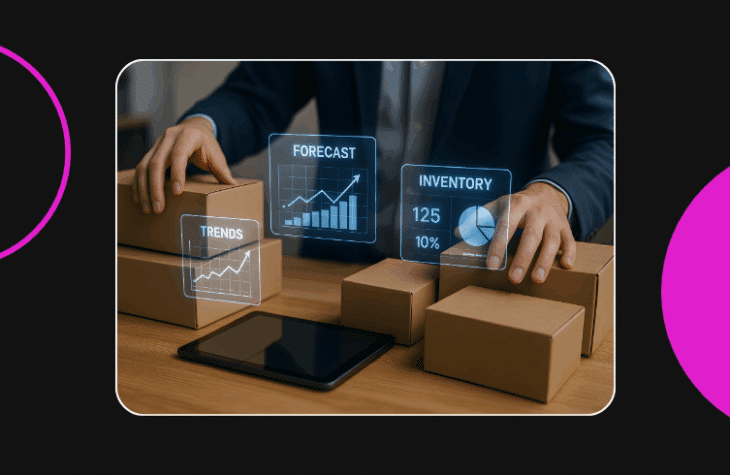Shopify Advanced Order Management: Key Software for Retail Shops

Shopify is great for launching businesses, but its built-in order management features become insufficient for scaling brands and complex omnichannel operations, leading to bottlenecks, data inconsistencies, and fulfillment delays.
An advanced Order Management System (OMS) centralizes orders, automates processes, optimizes inventory (including real-time multi-location visibility and intelligent routing), and supports complex fulfillment models like granular BOPIS and ship-from-store.
By integrating with an OMS like fabric, retailers can enhance operational efficiency, improve customer satisfaction, increase sales, leverage data-driven decision-making, and scale their Shopify operations to meet modern retail demands, including AI-powered insights.
Shopify has long been a powerful springboard for launching and scaling a thriving retail business. With its intuitive tools and robust ecosystem, it can empower you to bring your ideas to market quickly and reach customers across multiple sales channels, both online and in-store.
However, as operations grow more complex, so do the behind-the-scenes challenges.
Retailers managing higher volumes often face mounting issues—manual processes become bottlenecks, inventory data gets out of sync across channels, and fulfillment delays start to chip away at the customer experience.
While Shopify’s built-in order features are well-suited for early-stage growth, they aren’t always equipped to handle the layered needs of larger enterprises or omnichannel operations.
This is where an advanced Order Management System (OMS) can make a difference. It’s a software for retail shops designed to scale with complexity. An advanced OMS helps retailers automate processes, centralize orders, optimize inventory management, and deliver a seamless experience.
According to the U.S. Census Bureau, e-commerce sales in the U.S. reached $300.2 billion in Q1 2025, accounting for 16.2% of total retail sales. That’s a 6.1% increase over Q1 2024, highlighting the continued shift toward digital and omnichannel commerce and the need for scalable retail management software that keeps up with growing demand.
This article explains advanced OMS and explores how it goes beyond the standard Shopify capabilities to solve operational bottlenecks. We’ll examine the key differences between built-in tools and full-featured OMS. These common signs indicate it’s time for an upgrade, and the essential features to prioritize when choosing a solution.
Advanced OMS and how it differs from standard Shopify
An advanced OMS is a centralized, intelligent system that connects the dots across your entire order lifecycle—from the moment a customer clicks buy to final delivery. It doesn’t just track orders; it helps streamline operations, reduce human error, and automate the countless moving parts that drive modern retail sales.
While Shopify’s native tools are excellent for launching and running a single-channel store, the need for more robust retail management software becomes apparent as your commerce model expands to include in-store, online, and marketplace sales.
Here’s how an advanced OMS expands on Shopify’s foundation:
Unified view of orders and inventory
An advanced OMS consolidates inventory data, order status, and customer interactions from across all your channels—Shopify, Amazon, POS, marketplaces, social commerce—into a single source of truth. You get real-time updates on every transaction, allowing you to stay organized and respond faster to fulfillment needs.
This unified view supports better, smarter decisions and empowers your teams to manage customer orders without toggling between platforms or relying on disconnected spreadsheets.
Sophisticated inventory management
Rather than relying on basic inventory syncs, an advanced OMS gives you real-time inventory management across warehouses, stores, and even third-party logistics (3PLs). You can manage inventory across multiple nodes, forecast demand, and avoid overselling and underselling—key for preserving sales performance and customer trust.
In fact, 43% of supply chain professionals say real-time inventory visibility is the most critical capability for operational success.
Intelligent order routing
While Shopify offers a native foundational fulfillment logic, an advanced OMS can take things further with configurable automation. You can build intelligent rules that determine how and where each order should be fulfilled, based on proximity, stock availability, location capacity, shipping costs, and carrier performance.
This automation process logic helps you:
- Reduce shipping costs
- Improve delivery speed
- Save time during high-volume periods
- Lower the number of split shipments
By integrating your Shopify with an advanced OMS platform, you can enable deeper automation, access richer insights, and gain more flexibility, critical for large enterprises and brands with growing fulfillment complexity.
Complex fulfillment models
Shopify also offers BOPIS (Buy Online, Pickup In-Store), but it’s often limited to order-level logic and doesn’t offer line-item-level control. This means that your shoppers can’t always choose which items to pick up and which to ship.
fabric supports granular fulfillment capabilities like:
- Ship-from-store
- Curbside pickup
- Line-level BOPIS
- Dropship coordination
These services are essential for creating a unified commerce experience across digital and in-store touchpoints, and for turning into mini distribution hubs that drive more sales.
Advanced automation beyond basics
Beyond simple email notifications, advanced OMS software allows you to automate:
- Fraud checks
- Backorder workflows
- Purchase orders
- Payment status updates
- Returns and exchange flows
This kind of retail management system doesn’t just track your business; it helps you run it with control.
Opportunities to enhance your Shopify retail shop with advanced OMS software
Shopify is excellent at helping budding retailers launch and grow, but when daily operations become a maze of manual tasks, disconnected systems, and missed sales opportunities, it’s a signal that your business may have outgrown the basics.
Here are some clear signs that it’s time to invest in an advanced OMS software for retail shop setups that demand more precision, automation, and flexibility.
Managing operational hurdles
If your team is still manually processing orders, updating inventory spreadsheets, and fielding emails for order status, you’re not alone. Manual workflows increase the risk of human error and waste time that could be better spent on strategy or customer engagement. It becomes harder to stay organized and much harder to scale.
Navigating complex inventory management
Running out of stock or overselling is more than a technological hiccup—it’s a killer of customer loyalty. If you struggle to manage inventory across multiple sales channels, locations, or warehouse partners, your current system isn’t keeping pace. Without real-time inventory visibility, accurate purchase orders, and synchronized data, your retail management is flying blind.
Inconsistent customer experiences
One customer gets their order the next day, while another waits a week. One sees an item as available online, while another finds it out of stock at the local store. If customer and inventory data aren’t unified, shoppers receive conflicting information depending on the channel. That’s not just a bad experience—it’s a lost opportunity to build customer loyalty.
Scaling challenges
You’re expanding into new sales channels, offering new product lines, or growing your retail footprint. That’s great news until your current processes start breaking under pressure. Peak season spikes? Flash sales? Multi-location fulfillment? You’ll feel the struggle if your system isn’t built for agility.
High operational costs
From inefficient returns handling to expensive split shipments, your current workflows may be bleeding margin. Advanced OMS tools help automate processes, route orders more intelligently, and reduce resource-heavy interventions, cutting costs while improving efficiency and customer satisfaction.
Lack of visibility and control
You can’t improve what you can’t see. If you don’t have real-time insight into your order lifecycle, shipping performance, or product performance, you’re making reactive, not proactive, decisions. An OMS delivers the dashboards and analytics to empower smarter decisions—all from one system.
Visibility is no longer a luxury; it’s a necessity. In fact, 55% of supply chain professionals cite lack of visibility as their top challenge, while 43% consider real-time inventory visibility the most critical element in the supply chain. With 70% of companies planning to invest in technology to improve visibility in the next two years, it’s clear that actionable data is shaping the future of retail management.
Core benefits of implementing advanced OMS
Implementing an advanced Order Management System helps you unlock smarter, faster, and scalable retail operations. As Shopify-powered retailers grow, an OMS becomes a vital element that drives efficiency, boosts customer satisfaction, and opens doors to new revenue streams.
Here’s how the right software for your retail shop can transform your business:
Enhanced operational efficiency
Manual tasks like inventory updates, order routing, and fulfillment coordination drain valuable time and increase the possibility of human error. Advanced OMS tools automate processes, reducing the burden on your team while creating room to save time and focus on growth.
With streamlined workflows and centralized controls, you’ll no longer juggle spreadsheets and disconnected tools; you’ll be running your operations with precision.
Improved customer satisfaction
Faster, more accurate fulfillment, real-time customer data, and dynamic shipping options mean your shoppers get what they want, how they want it. Whether it’s BOPIS (Buy Online, Pickup In Store) or direct-to-door, advanced OMS platforms support a seamless customer experience across multiple sales channels.
Consistent, reliable services build trust, and trust builds long-term customer loyalty.
Increased sales and revenue
Out-of-stocks and fulfillment delays cost you more than a regular sale. They cost you future and potential customers. Advanced OMS solutions prevent missed opportunities by helping you manage pre-orders, backorders, and real-time inventory.
You can also expand into new markets, support multiple sales channels, and test complex fulfillment strategies without disrupting your backend.
Optimized inventory management
With real-time visibility into inventory data, you can reduce holding costs, improve inventory turnover, and prevent overselling or underselling. Advanced OMS solutions make tracking products across stores, warehouses, and 3PLs easy, offering accurate insights that keep your retail management agile and responsive.
You can even integrate with your point of sale (POS) systems for a complete view across physical and digital storefronts.
Data-driven decision making
Modern retail moves fast, and the businesses that win are the ones that can act on real-time insights. With built-in analytics and customizable dashboards, advanced OMS platforms help you understand sales trends, monitor product performance, and forecast demand.
Scalability for growth
Whether you’re entering new regions, adding new product lines, or scaling fulfillment options, a modern OMS provides the foundation you need. With API-first architecture, plug-and-play integrations, and modular capabilities, you’re set up for sustainable growth without sacrificing speed or control.
Source: Electro IQ
Essential features to look for in advanced OMS software
As your Shopify retail business scales, the ability to centralize, streamline, and automate becomes critical. That’s where a comprehensive retail management software can help by offering deep functionality and seamless extensibility.
These are some of the features you should look for when evaluating an advanced OMS:
Deep Shopify integration
An effective OMS should integrate real-time data, syncing orders, products, inventory, and customer data between Shopify and all other systems. Look for bi-directonal, real-time synchronization that enables smooth, consistent workflows and eliminates the risk of data silos.
When your backend speaks the same language as your storefront, it helps you stay organized, reduce errors, and deliver a more connected customer experience even post-purchases.
Centralized order hub
Managing orders across multiple sales channels can quickly become overwhelming. A strong OMS provides a single pane of glass to track every order from every channel in one intuitive dashboard. It becomes your command center to streamline operations, monitor transactions, and resolve issues quickly.
Real-time multi-location visibility
Whether you’re storing goods in multiple warehouses, stores, or through 3PLs, your OMS should offer real-time inventory management. It should sync across locations instantly, reducing human error and helping you better manage stock availability and purchase orders.
With this level of control, you can avoid stockouts, reduce holding costs, and support an endless aisle experience for shoppers.
Configurable order routing and orchestration rules
Basic systems assign orders based on default logic. Advanced OMS enables configurable, rule-based logic, so orders can be fulfilled from the most efficient location based on proximity, stock levels, shipping cost, or customer preferences.
This flexibility helps automate processes, reduce split shipments, and boost fulfillment speed, ultimately driving more sales and customer trust.
Workflow automation engine
Modern management software should let you automate workflows at every stage—fraud detection, order verification, fulfillment routing, even returns and exchanges. This improves efficiency and ensures smoother day-to-day operations with less manual overhead.
Comprehensive fulfillment management
Whether it’s BOPIS, ship-from-store, curbside pickup, or dropshipping, your OMS should support multiple fulfillment methods without complicated add-ons. Managing in-store fulfillment just as efficiently as online is key to unified commerce success.
You should also be able to set rules for prioritizing or assigning different fulfillment methods, which would give you more control over your customer promise.
Integrated returns and exchange management
A good OMS doesn’t just help you ship, it enables you to manage what comes back. From RMAs to refunds, look for tools that simplify and automate the returns process across all channels.
Robust reporting and analytics
You can’t grow if you don’t know what’s going on. Choose an OMS with dashboards and insights into everything from sales trends and product performance to employee output and shipping accuracy. This data helps you make smarter decisions and course-correct faster.
API-first architecture and extensibility
Scalability means flexibility. Platforms like fabric are built on API-first, modular architecture, meaning they integrate easily with other systems, whether that’s your POS, email marketing tools, or accounting platforms. This gives you room to grow without replatforming.
It’s an ideal feature if you’re looking to future-proof your tech stack with minimal technical debt.
User-friendliness and support
You can have all the features worldwide, but adoption will suffer if the platform is clunky or hard to use. Choose tools with intuitive interfaces, comprehensive onboarding, and responsive vendor support. It keeps your team operations and business running smoothly.
The future is optimized: How advanced OMS empowers retail
Retailers are expected to deliver a seamless customer experience across every touchpoint in today’s retail landscape. Meeting that expectation requires more than just surface-level tools; it calls for operational intelligence built into the foundation of your business.
That’s where a modern, AI-powered OMS comes in.
Powering true omnichannel commerce
An advanced OMS is the backbone of unified commerce, connecting every sales channel, fulfillment node, and customer interaction into one smooth, coordinated system. Whether a shopper buys online, returns in-store, or browses on mobile and completes the purchase through a marketplace, an OMS helps you orchestrate customer experiences precisely.
Furthermore, an advanced OMS platform, like fabric, built on a headless architecture, can allow you to plug into any front-end experiences while keeping the backend innovative, fast, and scalable.
AI in order management
Modern OMS platforms are increasingly powered by AI and machine learning, which transform retail management from reactive to proactive.
- Predictive analytics anticipate demand patterns, helping you optimize stock levels and avoid both overstocking and stockouts.
- Intelligent fraud detection automates risk screening during checkout, helping protect revenue without slowing down transactions.
- Automated recommendations streamline routing, bundling, and even fulfillment logic based on historical data and customer behavior.
It’s no longer a question of if retailers will adopt AI, but it’s a question of when and how soon. In fact, 89% of retail industry professionals say they either actively use AI in their operations or explore it through pilots and trials. This highlights the importance of investing in AI-powered retail management software to stay ahead of the curve.
Take control of your Shopify orders
As your retail business grows in size and complexity, so do the challenges behind the scenes. Manual tasks, fragmented inventory data, and fulfillment delays can all slow momentum and chip away at your customer experience. However, these hurdles can be converted into scalable systems with the right software for your retail shop.
fabric’s advanced OMS can enhance your Shopify operations. By adding intelligent automation, real-time visibility, and flexible fulfillment logic to your tech stack, you create a foundation that’s built for speed, agility, and growth.
Ultimately, investing in a robust OMS will ensure the future stability of your brand. By doing so, you’ll streamline operations, build customer loyalty, and empower your team to deliver seamless retail experiences across every channel.
Are you ready to scale and modernize your backend and confidently expand your retail operations? Book a demo with us today to explore and learn how fabric OMS can help transform your Shopify operations and set you up for long-term success.

Digital content editorial team @ fabric




